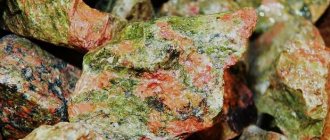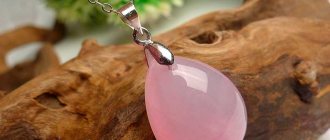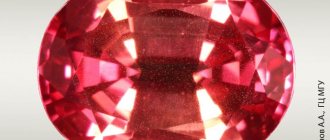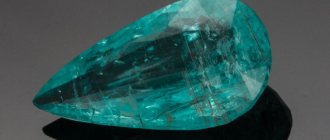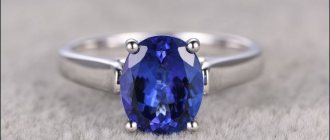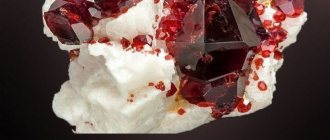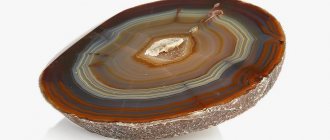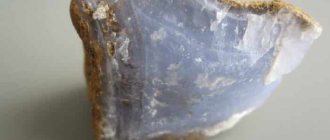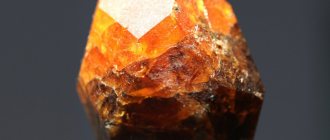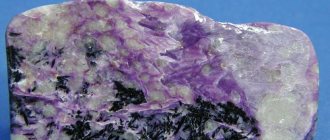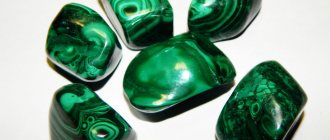| Category | Oxides (minerals) |
| Title in English | Agate |
| Formula | SiO2 |
| Group | Mineral, silica |
| Color | White, Grey, Blue, Yellow, Red, Black |
| Stroke color | White |
| Shine | Matte, Dull |
| Transparency | Translucent |
| singonia | Trigonal |
| Hardness | 6,5 — 7 |
| Cleavage | Missing |
| Density, g/cm³ | 2.6 g/cm³ |
| Kink | Rough, Conchoidal |
| origin of name | There are two options for the origin of the name Agate stone. According to the ancient Roman writer Pliny the Elder, the name of the jewelry and ornamental stone comes from the Achates River, which flows on the island of Sicily. Since those ancient years, the rivers have managed to change their names and there is an assumption that these are the Karabi or Dirillo rivers. According to the second version, the name of the stone comes from the Greek word “ἀγαθός”, which is translated into Russian as kind, good and happy. |
| Morphology | Agate is a dense chalcedony formation that contains inclusions of quartz, quartz and mechanical impurities such as goethite, hematite, celadonite, chlorite and others. |
Place of Birth
Agate deposits are very numerous.
— Advertising —
Large ones are located in the Urals, Chukotka, Moscow region, Georgia, Armenia, Tajikistan, Brazil, Mongolia, Uruguay, and India. Medium-sized deposits are located in Germany and Ukraine, in Crimea.
Story
The word "agate" is attributed to the Achates River, which is located in Sicily and where the oldest developed deposit of the mineral was discovered.
Another explanation comes from the Greek word “ἀγαθός”, which translates as kindness, happiness.
— Advertising —
Since the agate pattern is similar to an eye, there is a legend that it is the eye of a white eagle that fell to Earth in a battle with a black magician and turned into stone. And the bird's eye still looks at people, and divides good and evil deeds. Sometimes agate is called the Eye of the Creator.
History and origin
Agate is of volcanic origin. Quartz deposits form in the voids of rocks resulting from volcanic eruptions. They are washed by water with a high content of silica, which settles in these voids over time. As a result, blue agate is formed.
Blue agate stone cut
Although rare today, the history of blue agate dates back to BC. This is evidenced by chronicles of the 7th century BC, in which agate is mentioned as an amazing lace stone of heavenly color.
In 680 AD, the Greeks began building the city of Chalcedon on their way to the Bosphorus. On the territory of the future city, they discovered pale blue crystals with a lace pattern. In honor of the city, the stones found were called “chalcedony”. Pliny the Elder believed that the name “agate” is a derivative of the name of the river Achates. From Greek, “agathos” is translated as “happy, kind.”
The history of blue agate is filled with superstitions and legends. The ancient Romans believed that water mixed with the powder of this gem was an antidote to snake bites. Residents of the coast believed that the burned stone would stop the impending storm and storm.
Physico-chemical characteristics
- The chemical composition of the mineral is silicon oxide with impurities, its structure is heterogeneous. Resistance to acids is evident. Overall tough and durable.
- The stone consists of alternating layers of chalcedony and quartzine. They differ in the direction of fiber elongation: in chalcedony they are perpendicular to the quartz axis, and in quartzine they are parallel to it. Visually, quartzin is distinguished by its milky white color.
- Hardness is 6.5-7.
- Density from 2.6 to 4.7 g/cm3.
- The sparkle on a scrap surface is dull, greasy or matte, on a polished surface it is glassy.
- The mineral is opaque, translucent at the edges.
- The coloring is varied, most often gray-blue and white layers alternate.
Varieties of agate: photos with names and descriptions
Frost Agate
Frost agate stone
The gray-white mineral got its name due to the intricate pattern on the cut of the stone, like on windows after a severe frost.
Rainbow agate
Rainbow agate stone
Found under the name iridescent. This unusual gem contains thin layers of chalcedony capable of splitting light into spectral rays.
This is a multi-colored stone that can change its palette under the influence of light.
Brazilian agate
Brazilian agate stone
received its name from the place of extraction. A beautiful almond-shaped mineral of grey-blue color. The size does not exceed 10 cm in length.
Jewelers sometimes tint Brazilian agate to give it richness and richness.
It is this variety that, after staining, retains its texture perfectly and the pattern is clearly visible.
Royal agate
Royal agate stone
is known as obsidian. A beautiful mineral with a spotted color.
The combinations can be very different, from black and dark gray to snow-white and rainbow layers and splashes.
Timan agate
Timan agate stone,
like Brazilian agate, is named after its deposit. It is mined in the Timansky Ridge highlands in Russia.
It is distinguished by large samples (up to 20 cm) and a variety of shapes (pear-shaped stones, round, cone-shaped).
Cutting them off makes it possible to admire the landscape pattern of a mountain landscape or gray-blue combinations of stripes, reminiscent of the atmosphere of white nights.
And if you’re lucky, you can find a Timan gem with a lilac glow; it is associated with the northern lights.
Eye agate
Ocellated agate stone
Sometimes jewelers and gemologists say “ocellited”, “owl’s eye”, “Aleppo stone”, which does not change the essence.
This is one of the most beautiful types of gem. The section shows how the concentric layers form a circle similar to the eye.
Agat dzi
Agate dzi stone
This is the name given to the gem after engraving a special design for the famous Tibetan beads.
Eyes, squares, stripes, wavy lines are artificially applied and symbolize ritual signs.
The teachings of Dzi are older than Buddhism and are associated with shamanism. Therefore, beads made from such agate carry magical powers.
Kinds
Based on the thickness of the layers, they are distinguished:
- Thin-banded agate (0.5-1 mm);
- Broadband agate (from 1 mm);
- Rough banded agate (from 10 mm);
- Variegated agate (from 0.5 mm to 10 mm).
According to the drawings there are agates:
- Bastion - patterns resemble old maps;
- Ocellar layers are concentric, forming a pattern resembling an eye;
- Dendritic - have tree-like or fern-like patterns;
- Moss – the pattern looks like moss thickets;
- Landscape - with intricate patterns;
- Iridescent or iridescent;
- Onyx - with multi-colored layers.
Based on the color of the layers, they are distinguished:
- Carneolonyx (red and white);
- Sardonyx (brown and white);
- Arabic onyxes (black and white);
- Chalcedonyx (bluish-gray and white).
Features of care and wearing rules
Agate is undemanding, so no special care is needed. To clean, a soft cloth and soap solution is enough. Storage is recommended in a woven bag. To keep the specimen bright, protect it from direct sunlight.
The mineral is attractive due to its unusual variegated color. This makes it difficult to incorporate into the image. To ensure that the decoration fits in, take into account the rules of etiquette and the recommendations of stylists.
General tips:
- Agate jewelry with silver is suitable for the office;
- the breed is appropriate at any age;
- for the holiday they wear gold items with minerals;
- the best choice is moss and landscape stones;
- it is preferable to fit the breed into a business, casual or exotic look;
- the black variety looks better solo, recommended for dark-eyed brunettes;
- the white variety goes with any clothing;
- pink agate jewelry is suitable for girls;
- red is combined with white, black, gray or red clothes;
- golden and milky varieties are the most stylish.
The mineral is ideal for an everyday look
Agate is combined with plain clothes or a suit, the pattern of which completely matches the stone.
Stylists advise:
- red stone for brunettes;
- blue for blondes;
- green to red.
An important aspect of care is energy cleansing. Recommended twice a month. The stone is washed with running spring water or placed in salt for a day.
Medicinal properties
Ancient people considered agate a stone of long life and health. Its medicinal properties depend on the color scheme. Thus, light gray-white agates strengthen the body; special bracelets are made from them. Blue agates normalize the functioning of the thyroid gland, yellow agates help with throat and liver diseases. Red stones are recommended for diseases of the heart and blood vessels in the form of a ring for the ring finger of the left hand. Black agate increases potency.
All agate products protect against infectious diseases, help fight fears and cure insomnia.
Properties ?
Agate is a variety of the ubiquitous quartz, silica. It has a layered structure and different colors of layers.
Physico-chemical?
- Resistant to acids; He is only afraid of hydrofluoric acid.
- There is no pleochroism, no fluorescence.
- Does not show through in pieces or thick layers. Translucent in thin sections.
- The pattern appears either very clearly, with differently colored layers, or the pattern is almost not noticeable.
Do litotherapists advise?
Agate beads, brooches and pendants are useful to wear for diseases of the bronchi and lungs.
Wear earrings when you have a toothache.
Lithotherapists claim that agate will help with various diseases.
| Type of agate | Therapeutic effect |
| Red | Provide relief from cardiovascular diseases |
| Grey | Strengthens immunity, improves health |
| Blue | Improves the condition of hypo- and hyperthyroidism |
| Yellow | Treats liver and gallbladder diseases |
| Black | Increases potency in men |
Important: do not forget that lithotherapy is only an assistant, and let the doctor carry out the treatment.
The magic of a lucky stone?
Agate is one of those “inconvenient” stones that force a person to tell the truth
